Abstract
Common breast conditions during lactation are multifold. Simple breast engorgement to an abscess, a galactocoele to a tumor, which may be benign or malignant or an infection with bacteria, virus or fungus, simple traumatic injury to the disorders of musculoskeletal system, or vascular disorders like Raynaud of nipple.
All all are the frequently found ailments in a good number of lactating mothers, especially those who have delivered through a cesarean section. All the factors must be evaluated carefully and treated in time to avoid unexpected outcomes. Homoeopathy has a lot of potential to establish a prefect cure in holistic manner.
Mastitis, Lactational mastitis, Milk fever, Lactation, Puerperium, Breast abscess, Galactocoele, Homoeopathy, Breast cancer
Common breast problems in the puerperium
The most common problems faced during lactation are summarized below. These may be benign or malignant.
Benign conditions
These may be the conditions related to lactation, benign breast disease, musculoskeletal issues or Raynaud’s disease of nipple.
Conditions related to lactation
- Engorgement
- Breast infection (mastitis or abscess)
- bacterial infection – usually S. areus
- fungal infection (C. albicans; uncommon)
- viral (herpes; very rare)
- Galactocoele (non-infected milk-filled cyst)
- Nipple pain
- cracked/damaged nipples
- incorrect attachment: misalignment of mother’s nipple and baby’s mouth

- infant causes: poor sucking, tongue-tie, cleft palate
- incorrect use of breast pump
- albicans nipple infection
Other conditions
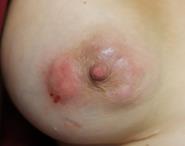
Benign breast disease
- Fibroadenoma
- Fibrocystic change
- Cyst
- Galactocoelee
- Benign phyllodes tumour
Musculoskeletal conditions
- Tender costochondral junctions (Tietze syndrome)
- Sleeping or breastfeeding in an uncomfortable position
Raynaud’s disease of the nipple
Raynaud’s phenomenon is a well-described pathologic state in which there is episodic vasospasm followed by vasodilation. Raynaud’s phenomenon of the nipple may result in discontinuation of breastfeeding secondary to pain and disruption of the maternal-infant bonding process.
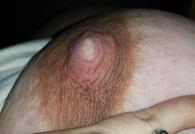
Malignant causes
Breast cancer
- Lobular and ductal carcinoma
- Inflammatory breast cancer (may mimic bacterial mastitis)
- Malignant phyllodes tumour
Lactational mastitis
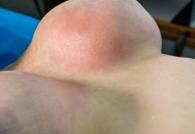
This is the most common condition. The term lactational mastitis includes a range of disorders in the lactating breast from ductal inflammation to acute bacterial infection that occurs in the initial postpartum period mostly due to hyperlactation, milk stasis, disruption of the milk microbiome etc.
Lactational mastitis is the progression of constant milk obstruction to inflammatory mastitis and then acute bacterial mastitis if untreated.
Synonyms of lactational mastitis
- Acute nonepidemic mastitis
- Benign inflammation of the lactating breast
- Benign lactation-related breast inflammation (BLBI)
- Lactation mastitis
- Mastitis spectrum
- Milk fever
- Puerperal mastitis
Pathogenesis of lactational mastitis
The breast engorgement is often bilateral, global breast enlargement that occurs due to constant milk obstruction by increased mammary blood flow and milk production as a result of secretory activation of the mammary glands.
It characteristically presents as bilateral breast pain, firmness, and swelling 3-5 days postpartum to 9-10 days postpartum, mainly in mothers with cesarean birth. It may lead to mastitis if breast milk is not emptied timely.
Types of lactational mastitis
Inflammatory mastitis
It occurs when ductal narrowing persists or worsens and presents as focal area of induration or more globally congested, tender breast tissue not typically associated systemic symptoms. Primary cause of inflammatory mastitis is milk stasis which may occur due to-
- Unsuccessful suckling
- Poor attachment of infant at breast
- Unexpected alterations in feeding frequency
- Blockage of milk ducts
- Increased production of milk
- Ill managed engorgement
- Pressure against the breast obstructing the drainage
- Weaning
- Lactating for twins or other multiples
- Nipple trauma
Acute bacterial mastitis
It represents development from ductal narrowing and inflammatory mastitis to an infection. It presents as cellulitis in a definite region of the breast that may spread to other areas of the breast and is often concomitant with systemic signs like fever, tachycardia, and malaise. The common organisms involved include-

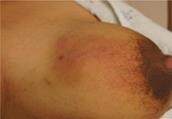
- Staphylococcus
- Streptococcus
Phlegmon
It is a firm, mass-like area of blurry fluid formation without a focal drainable collection and often presents with pain, erythema, and systemic symptoms. It may be caused by excessive deep tissue massage causing ductal narrowing and inflammatory mastitis.
Lactational breast abscess
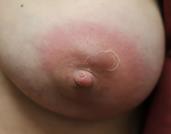
It is the progression from partly treated acute bacterial mastitis or galactocoele to infected fluid collection that needs drainage. It is reported in about 3%-11% of patients with acute mastitis and presents as progressive induration and erythema often with a palpable fluid collection in a well-defined area of the breast along with systemic signs and symptoms.
Subacute mastitis
It is the narrowing of ductal lumens by bacterial biomes causing chronic mammary dysbiosis, also called as disruption of milk microbiome. There is often a history of previously treated acute bacterial mastitis. Local breast symptoms may be insignificant than with acute mastitis and systemic symptoms are uncommon.
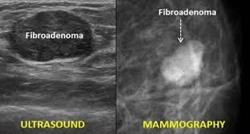
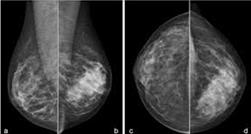
Fibroadenoma
Fibroadenoma is a most common benign solid tumour composed of stromal and epithelial elements.
Fibrocystic change
Fibrocystic breast changes (formerly called as fibrocystic breast disease) is a condition of the breasts where there may be pain, breast cysts, and breast masses, making them lumpy or doughy. Symptoms may get worse during certain days of the menstrual cycle. It is not associated with cancer.
Risk factors include an early age at first menstrual period and either having children late or not having children. It is not a disease but represents normal breast changes. Diagnosis typically involves ruling out breast cancer.
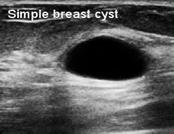
Breast cyst
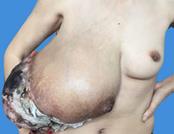
Breast cysts are circumscribed fluid collections commonly occurring in premenopausal women. The typical presentation includes single or multiple breast masses of variable size which may be tender. Breast cysts are characterized as simple, complicated, or complex.
Benign phyllodes tumour
Phyllodes tumor is a rare type of breast tumor. These are rare fibroepithelial lesions and are also known as cystosarcoma phyllodes.
Lobular and ductal carcinoma

Invasive lobular carcinoma appears in breast’s lobules and spreads to nearby tissue. ILC is the second most common type of invasive breast carcinomas.
Ductal carcinoma represents a neoplastic proliferation of malignant gland-forming cells. It may be in situ or infiltrating to adjacent areas.
Inflammatory breast cancer
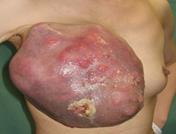
Inflammatory breast cancer is aggressive and fast-growing breast cancer in which cancer cells infiltrate the skin and lymph vessels of the breast. It may mimic bacterial mastitis.
Malignant phyllodes tumour
It is a rare fibroepithelial neoplasm of the breast having an unpredictable clinical course. Metastases in PT may occur either at the time of primary presentation or may be as late as 12 years after the diagnosis.
Homoeopathy for Common Breast Conditions
Homoeopathic treatment being the holistic one, rapidly cures the breast conditions if the correct remedy is chosen on the basis of simillimum.
Most common drugs for breast conditions
Arnica montana
Erysipelatous inflammation of the mammæ and and nipple; inflammation of the breast following a contusion; soreness of the nipples. Worse in the evening, and at night; also, from motion, and from touch. Better when lying down. Right side.
Belladonna
The remedy in all glandular swellings of an inflammatory character with rapid swelling threatening suppuration. Swollen glands in the axillary region, especially at the climaxis, or swellings of the mammae, which are heavy, red and sensitive. Red shining streaks radiating from the glands with great heat and stitching pains indicate Belladonna. The glands, though swollen, are never purple or gangrenous; the inflammation involves the substance of a gland, Apis more the surface.
Calcarea carb
Breasts are hot and swollen. Chronic cystic mastitis. Blunt duct adenosis; best remedy for fibroadenoma. Lump in breast is hard, nodular and tender to touch in the beginning. Then the pains are reduced and the lump turns to be hard due to calcification. Calcarea acts best when the tumours are calcified. These breasts are swollen and tender before menses. Deficient lactation. The breasts are distended in lymphatic women. Patient complains of profuse sweating around the genitalia with dirty smell. Inflammatory condition of the breast. With breast condition patient has the mental symptoms due to sufferings. Patient is anxious, tired and weak, both mentally and physically.
Carb-an.
Induration of axillary and inguinal glands, particularly in syphilitic and gonorrhoeal patients; buboes are hard as stone, were opened too early, leaving surrounding tissue of stony hardness; mammary cancer, gland indurated in little nodes, small portion of it hard as stone, with burning, drawing pain through breast axillary glands indurated; goneness and empty feeling in stomach, not relieved by eating.
Conium maculatum
Mammary glands are hard and sore. A typical carcinoma of the breast, that is, scirrhous adenocarcinoma, which begins in the ducts and ends in the parenchyma. As the stage advances the Cooper’s ligament shortens and thus it produces the notch. Sometimes the condition is associated with the inflammation of the breast tissue. The region is hard and nodular, tender to touch. Burning and stinging pains in the breast. The skin over the tumour is adherent. Occasionally there is discharge of pus from the nipple. The lesion is hard, almost cartilaginous. The edges are distinct, serrated and irregular; associated with productive fibrosis.
Graphites
The skin over the breast is rough and hard. Dryness of the skin near areola. The skin eruptions are itching and associated with exudate, which is watery and transparent. Frequently progresses to suppuration. In lactating cases, the patient suffers from mastitis in the very first month. The discharges from the ulcers on the breast are thin and sticky. There is swelling and induration of the axillary lymph nodes. The inflammation has tendency to form fibroma. There are fissures and cracks on the nipples and areola, which are very tender and sensitive. Hard cicatrices appear after mammary abscesses. This results in suppression of the milk flow. There is herpetic eruptions on the breast.
Hydrastis Canadensis
The tendency to indurated glands. Swelling of the mammary glands. Fat necrosis and glandular cell myoblastoma are common in this remedy. Fat necrosis tumour is probably post-traumatic. Patient complains of pain and tenderness. The lesion is fixed to the breast tissue, which sometimes causes dimpling of the overlying skin. Engorged nipples, cracks and discharges of watery fluid or there is serosanguinous discharge.
Phytolacca decandra
Mastitis with enlarged axillary lymph nodes. This mastitis is secondary to pyogenic infections. Due to engorgement with milk in the early days of lactation, where one of the lactiferous ducts becomes blocked with epithelial debris. Soreness and intense pains in breasts, Breasts indurated and tender. Papular and pustular eruptions on the mammary region which have no tendency to heal. Squamous and syphilitic eruptions on the breasts. The nipples hard, red and tender to touch. She does not allow to touch the parts. Restlessness due to inflammation is the general guiding symptom. Engorgement of lymph nodes secondary to local inflammation.
Silicea
Sharp pain in breasts or uterus pain in back increase in lochia. Pure blood flows every time she put the child to breast. Aversion to mother’s milk. Inflammation of nipples darting, burning pain in nipple. Nipple drawn in like a funnel. Inflamed breast, deep red in center, rose-colored towards periphery, swollen, hard, sensitive constant burning pain, prevents rest. The SILICIEA patient is yielding anxious head sweats at night.
Thuja
The left female mamma hard. Drawing pains, swelling of both breasts. An ulcer on the right nipple, with violent pain in the whole breast. Sensitiveness and heaviness of the breasts after the menses, with cutting pain in the nipples, surrounded by a brown areola, as in pregnancy. Feeling, when seated, as though the breasts were compressed, from before backward, agg. by stretching the body. Pressing in the left breast, after the sensation in the lower lobes of the lungs, especially when breathing deeply. Constant painful pressure from within towards the nipple.
Short repertory of common breast conditions
- CHEST – CANCER – Mammae – last stage: (2) carb-an. lac-c.
- CHEST – CANCER – Mammae – last stage – mastectomy of opposite cancerous mamma; after: (1) lac-c.
- CHEST – CANCER – Mammae – metastasis – Bones; to: (9) calc. carb-ac. carb-an. con. lach. merc. nit-ac. phos.
- CHEST – CANCER – Mammae – old people: (1) carb-an.
- CHEST – CANCER – Mammae – scirrhus: (13) brom. carb-an. CON. cund. GRAPH. Hydr. kreos. lap-a. phyt. sars. Scir. Sil.
- CHEST – CANCER – Mammae – scirrhus – accompanied by – menses; absent: (1)
- CHEST – INDURATION – Mammae: (72) alum-sil. alumn. ambr. anan. apis Arn. ars. Ars-i. Aster. Aur. BAR-I. Bell. Bell-p. Bry. bufo Calc. calc-f. calc-i. calc-p. CARB-AN. Carb-v. Carbn-s. carc. CHAM. chim. Cist. Clem. coloc. CON. Crot-h. Crot-t. cund. Cupr. cycl. dulc. Graph. hep. Hydr. hyos. ina-i. Iod. irid-met. KALI-CHL. Kali-m. Kreos. Lac-c. lach. lap-a. Lyc. mang. Merc. nit-ac. petr. Phos. Phyt. plb. Plb-i. puls. Rhus-t. ruta sabin. sang. Sep. SIL. spong. sul-i. Sulph. Thuj. tub. ust. vip.
- CHEST – INDURATION – Mammae – right: (10) CON. graph. hydr. irid-met. kali-chl. lyc. Phyt. thuj. vip.
- CHEST – INDURATION – Mammae – left: (9) calc. carc. CON. Cund. KALI-CHL. lap-a. phyt. SIL.
- CHEST – INDURATION – Mammae – abscess, after: (2) Graph.
- CHEST – INDURATION – Mammae – blows; after: (4) bell-p. carb-an. Con.
- CHEST – INDURATION – Mammae – children; in – infants: (1)
- CHEST – INDURATION – Mammae – cicatrices, in: (2) phyt.
- CHEST – INDURATION – Mammae – contusion, after: (7) ars-i. Bell-p. carb-an. Con. cund. kali-chl.
- CHEST – INDURATION – Mammae – menses – absent: (1)
- CHEST – INDURATION – Mammae – menses – before – agg.: (4) Con. lac-c. sang.
- CHEST – INDURATION – Mammae – menses – during – agg.: (2) carb-an.
- CHEST – INDURATION – Mammae – painful on touch: (7) con. cund. hydr. Kali-chl. Phyt. thuj.
- CHEST – INDURATION – Mammae – red; but not: (2) con.
- CHEST – INDURATION – Mammae – stone; like: (1)
- CHEST – INDURATION – Mammae – Nipples: (8) Bry. Calc. Carb-an. graph. Merc. sulph. thuj.
- CHEST – TUMORS – Mammae: (55) arn. ars-br. ars-i. aster. Bell. berb-a. brom. bry. calc. Calc-f. calc-i. Calc-p. calen. Carb-an. cham. chim. clem. CON. Cund. ferr-i. gnaph. Graph. hecla Hydr. Hyos. iod. kali-i. Lach. lap-a. lyc. merc. merc-i-f. murx. nit-ac. osm. ph-ac. phel. Phos. Phyt. plat. Plb-i. psor. Puls. sabin. sang. Scir. Scroph-n. sec. Sil. skook. tep. thuj. thyr. tub.
- CHEST – TUMORS – Mammae – left: (1) Calc-p.
- CHEST – TUMORS – Mammae – accompanied by – perspiration; hot: (1) merc-i-f.
- CHEST – TUMORS – Mammae – accompanied by – Stomach; complaints of: (1) merc-i-f.
- CHEST – TUMORS – Mammae – fibrocystic: (4) phyt. puls. sil.
- CHEST – TUMORS – Mammae – fibroid: (1)
- CHEST – TUMORS – Mammae – injury from: (2) con.
- CHEST – TUMORS – Mammae – painful: (2) phyt.
- CHEST – INFLAMMATION – Mammae – delivery – after: (13) BELL. bry. calc. carb-an. carb-v. con. graph. merc. Phos. puls. SIL. sulph.
- CHEST – INFLAMMATION – Mammae – nursing mothers; in: (3) bamb-a. sil.
- CHEST – INFLAMMATION – Mammae: (72) acon-l. anan. ant-t. Apis arg-met. arn. ars. bamb-a. BELL. bell-p. BRY. bufo Cact. Cadm-s. calc. calc-f. CAMPH. cann-s. Carb-an. Carb-v. Carbn-s. carc. Card-m. Castor-eq. Cham. Cist. clem. Con. Crot-t. cur. dulc. ferr. ferr-p. fl-ac. galeg. graph. helon. HEP. lac-ac. lac-c. Lach. laur. Lyc. Merc. Merc-d. morg-p. naphthoq. op. petr. phel. Phos. PHYT. pic-ac. plan. plb. Puls. pyrog. rhus-t. sabad. sabal Samb. sep. SIL. SULPH. tub. urt-u. ust. verat-v. viol-o. vip-a. x-ray
- CHEST – INFLAMMATION – Mammae – right: (2) phel.
- CHEST – INFLAMMATION – Mammae – left: (2) PHYT.
- CHEST – INFLAMMATION – Mammae – delivery – during: (1)
- CHEST – INFLAMMATION – Mammae – pregnancy agg.; during: (2) Bry.
- CHEST – CANCER – Mammae: (113) aids. alum. alum-sil. alumn. Apis Arg-n. arn. Ars. Ars-i. ars-s-f. Aster. Aur-ar. aur-m. aur-m-n. aur-n-f. bac. Bad. bapt. bar-i. Bell. Bell-p. Brom. bry. BUFO cadm-calc-f. cadm-met. calc. calc-f. calc-i. calc-p. calc-sil. calen. Carb-ac. Carb-an. carb-v. carbn-s. carc. caust. cham. Chim. cic. cist. Clem. coenz-q. coloc. CON. congo-r. Cund. cupr. cypr. durb. elaps ferr. ferr-i. form-ac. formal. gaert. Gali. goss. GRAPH. Hep. hip-ac. hippoz. Hydr. hyper. ign. iod. kali-br. kali-c. Kali-i. kreos. lac-c. Lach. lap-a. lob-e. Lyc. mag-c. MERC. Merc-d. Merc-i-f. naja nat-c. nat-tmcy. Nit-ac. ol-an. Ox-ac. ph-ac. Phos. Phyt. plb. Plb-i. Psor. Puls. rad-br. rhus-t. ruta Sang. sars. scir. scroph-n. sed-r. semp. Sep. SIL. streptom. strych-g. sul-i. Sulph. tarent. thuj. tub. zinc.
- CHEST – CANCER – Mammae – right: (10) ars-i. Con. ferr-i. gaert. GRAPH. HYDR. PHYT. sars. Sil.
- CHEST – CANCER – Mammae – left: (14) ars-i. aster. Caust. clem. CON. Hydr. ign. lach. nit-ac. puls. scroph-n. Sil. thuj.
- CHEST – CANCER – Mammae – nightly pains: (1)
- CHEST – CANCER – Mammae – accompanied by – discharge – offensive: (1) carb-an.
- CHEST – CANCER – Mammae – accompanied by – hemorrhage: (10) durb. elaps kreos. lach. Phos. plb. sang. strych-g. thuj.
- CHEST – CANCER – Mammae – accompanied by – hemorrhage – bright red blood: (1)
- CHEST – CANCER – Mammae – accompanied by – hemorrhage – copious with serum and blood: (1)
- CHEST – CANCER – Mammae – accompanied by – hemorrhage – dark thick clots: (1) elaps
- CHEST – CANCER – Mammae – accompanied by – hemorrhage – pain; with: (1)
- CHEST – CANCER – Mammae – accompanied by – induration of the mammae: (5) alum-sil. aur-n-f. cadm-calc-f. CON.
- CHEST – CANCER – Mammae – accompanied by – itching: (1)
- CHEST – CANCER – Mammae – accompanied by – pain: (10) cadm-met. carb-an. hippoz. lap-a. lob-e. nat-tmcy. ol-an. phyt. streptom.
- CHEST – CANCER – Mammae – accompanied by – pain – burning pains: (3) carb-an. lap-a. ol-an.
- CHEST – CANCER – Mammae – accompanied by – pain – operation; after surgical: (2) streptom.
- CHEST – CANCER – Mammae – accompanied by – pain – radiation; after: (2) streptom.
- CHEST – CANCER – Mammae – accompanied by – pain – stitching pains: (3) lap-a. ol-an.
- CHEST – CANCER – Mammae – accompanied by – pain – violent pain: (1) nat-tmcy.
- CHEST – CANCER – Mammae – accompanied by – swelling of mammae: (1) cadm-calc-f.
- CHEST – CANCER – Mammae – accompanied by – ulcers: (4) alum-sil. aur-n-f. bell-p. coenz-q.
- CHEST – CANCER – Mammae – accompanied by – Axillary gland; enlarged: (6) alum-sil. aur-n-f. carb-an. CON. goss.
- CHEST – CANCER – Mammae – accompanied by – Uterus and shoulders; stitching pain in: (1)
- CHEST – CANCER – Mammae – cicatrices, in old: (1)
- CHEST – CANCER – Mammae – contusion; from: (7) Bell-p. calen. carb-an. Con. hyper. Ruta
- CHEST – CANCER – Mammae – contusion; from – gangrene; with: (1) carb-an.
- CHEST – CANCER – Mammae – epithelioma: (20) Arg-n. Ars-i. brom. BUFO calc. calc-p. Clem. CON. Hydr. Kreos. Lach. merc. Merc-i-f. Phos. Phyt. Sep. Sil. sulph. thuj.
- CHEST – CANCER – Mammae – fungous: (2) CARB-AN.
- CHEST – CANCER – Mammae – injuries; after: (2) bell-p.
Bibliography
Breast Disorders > COMPLICATIONS OF LACTATION Book: Tintinalli’s Emergency Medicine: A Comprehensive Study Guide, 9e …Complications Of Lactation Table 104-2 Mastitis, Abscess, and Hidradenitis …
Encyclopedia Homoeopathica
Radar 10
The Breast > Bacterial Infection Book: Schwartz’s Principles of Surgery, 11e … hospital-acquired puerperal infections of the breast are much less common, but nursing women who present with milk stasis…
Radar Opus 2.1.11
© Dr. Rajneesh Kumar Sharma M.D. (Homoeopathy)



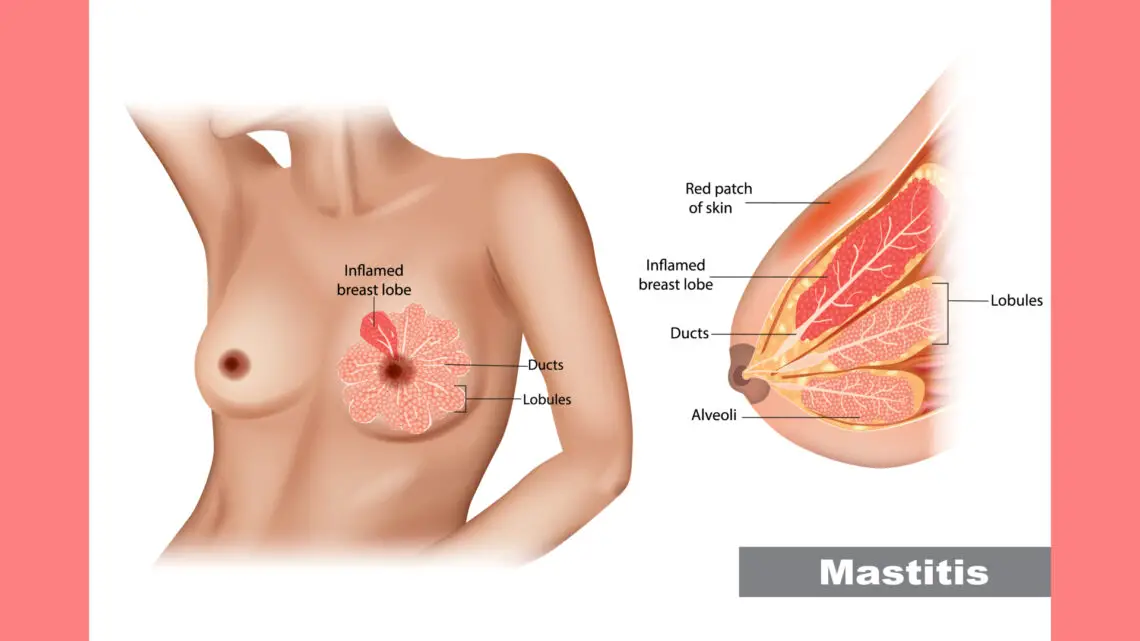
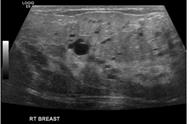

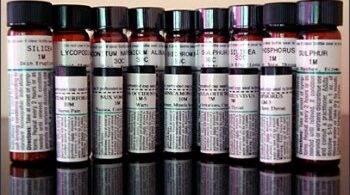

Thank you for this article Dr. Sharma. I’ve read your work before, and you have a wonderful grasp of how to approach cases.of deep pathology.
Thanks a lot sir.